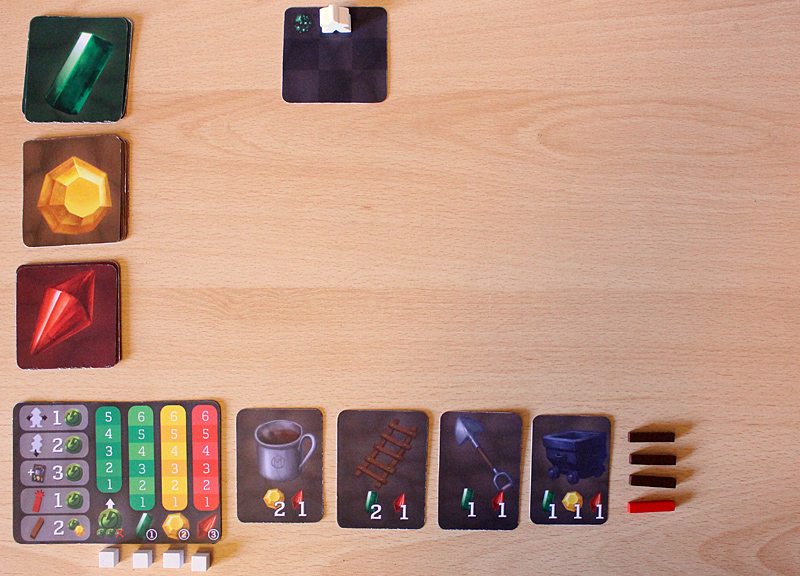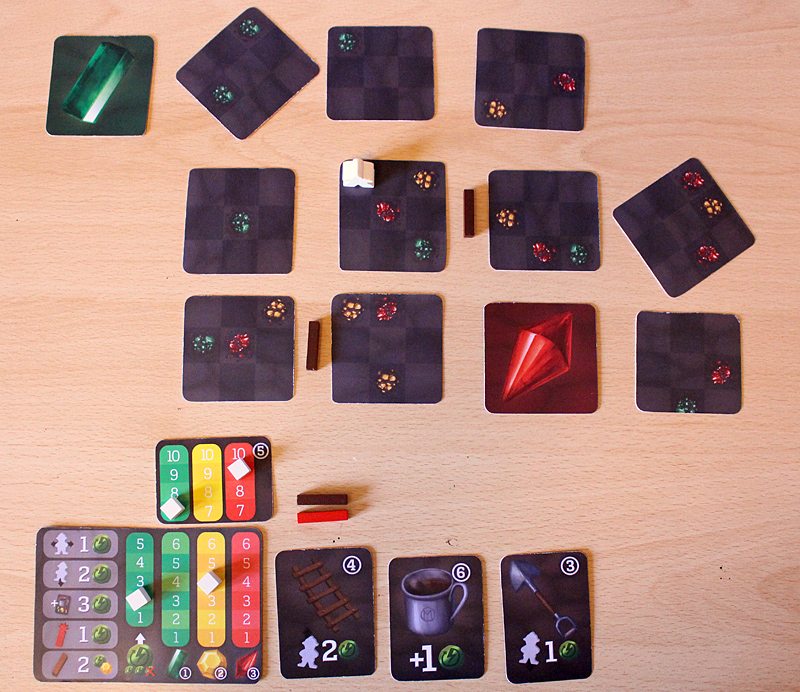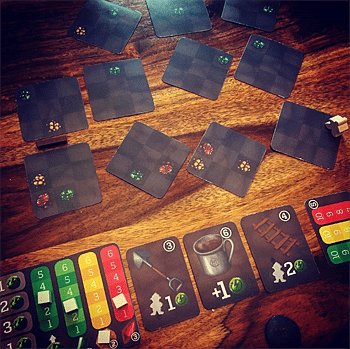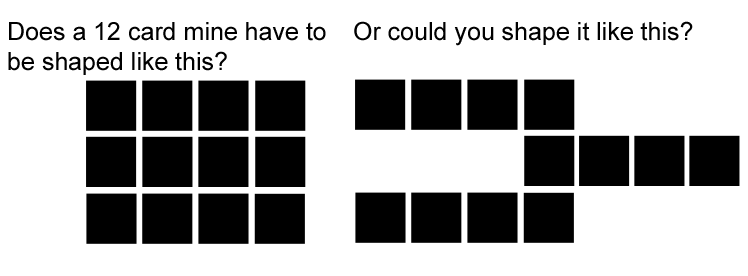
*POST UPDATE: Responses from game designers at the end*
At a Glance:
Mined Out is a short, easy-to-learn game in which players compete to expand their mines, buy upgrades, and dig up gems. The player with the most points – earned from upgrades, gems, and uncollapsed mine cards – when the end of the game is triggered, is the winner. The game is currently available to back on Kickstarter.
New to Kickstarter? Check out our crowdfunding primer, and visit our curated page for more projects we love.
Components:
- 16 Green Mine Cards
- 16 Yellow Mine Cards
- 16 Red Mine Cards
- 16 Resource Cubes
- 16 Upgrade Cards (4 each of Coffee, Shovel, Ladder, & Mine Cart)
- 12 Wooden Supports
- 4 Sticks of Dynamite
- 4 Player Cards
- 4 Meeples
How to Play:
Each player is assigned four green, four yellow, and four red mine cards, four resource cubes, one of each upgrade card, a player card, meeple, 3 wooden supports, and a stick of dynamite. The mine cards are stacked into three piles and placed in a column with green at the top, yellow below, and red at the bottom. One green card is flipped over and placed on the top row of the mine with the meeple in the top, middle space of the card to create a start point. As the mine cards are placed during the game, they will create a grid.

On each turn, players are given three action points (AP) to spend. They can perform any of the following actions on their turn:
- Move one space horizontally – 1AP
- Move one space down – 2AP (1AP if the shovel is owned)
- Move one space up – 2AP (only if ladder is owned)
- Buy an upgrade – 3P (plus gem cost lited on each card)
- Blow up an opponent’s mine card – 1AP (once per game)
- Place a support – 2AP (plus two yellow gems)
- Bank AP for next turn
There are four upgrades available:
- Coffee – Gives one extra AP each turn after it is bought
- Ladder – Allows players to move upwards in their mine
- Shovel – halves the cost of moving downwards in the mine
- Mine Cart – expands the number of gems you can hold at one time from six to ten.
The end of the game is triggered when a player buys their fourth, and final, upgrade.
In addition to the 3AP it costs to buy an upgrade, each upgrade has a cost in gems:
- Coffee – 2 Yellow, 1 Red
- Ladder – 2 Green, 1 Red
- Shovel – 1 Green, 1 Red
- Mine Cart – 1 Green, 1 Yellow, 1 Red
Gems are gathered by moving through your mine. Each mine card is made up of 9 spaces in a 3×3 grid. Landing on a gem space on a mine card automatically mines that gem and the gem is added to your player card by moving your resource cube one up the appropriately coloured track. However, once you have gathered a gem from a mine card, that section of the mine becomes shaky and unstable – indicated by placing the card at a 45-degree angle. If you land on another gem space on the same card, the gem is added but that mine section collapses (the card is flipped over) and can no longer be mined. This can be avoided by placing wooden supports between mine cards. The sections of mine either side of a support can be mined indefinitely unless an opponent plays their dynamite on your card and blows the section up.

Players move around their mine, adding new cards from the stacks (up to a maximum of 16) to expand the mine sideways and downwards, gathering gems and buying upgrades until a player triggers the end of the game by purchasing their final upgrade card. At this point, points are tallied up. Players receive:
- The points indicated on each of the upgrade cards they have bought so far (coffee 6, ladder 4, shovel 3, mine cart 5)
- Points for each gem in their inventory (greens are worth 1, yellows 2, and reds 3)
- Two points for each uncollapsed card in their mine
- Two bonus points if they have not played their dynamite during the game
Verdict:

Mined Out is a fun little game that’s easy to learn and quick to play. My husband and I played several games of the prototype we were sent and were able to follow the rules easily with only a few hiccups, we later played with our seven-year-old son who picked up the rules of the game quickly as well. The game does well at mixing together a good deal of strategy – choosing which order to buy upgrades, whether to allow sections of mine to collapse in order to get a much-needed gem, and deciding where to place supports – with a substantial dollop of luck. The cards are assigned randomly so you can end up with a mine filled with green and yellow gem cards but no red, or some other equally unhelpful combination. After several games, I found myself thinking how excellently the game would work as an app, with shaking cards for unstable sections of the mines and cute little animated miners walking about, digging, and tossing gems into a cart. I want to play it now!
There were a few rules that we felt needed further clarification as we played, hopefully, these points will be addressed in the final version of the game. *UPDATE: Responses to these points from the game designers at the end* Four of the biggest points we would like to see clarified are:
1. Once a support is in place, can the same gem space be mined indefinitely? This is how we played, but as some cards contain spots for all three gem colors, players can simply move around within those few spots rapidly gathering up gems.
2. What happens during a chain reaction mine collapse? During one game, our son chose to mine a second gem from an already shaky card. He was standing on the top right space on the card that collapsed, so the collapse pushed him to the top left of the card beside him. This card was already shaky and because he landed on a gem space (the rules state that in a collapse, your meeple moves “to the nearest space outside the card”) it collapsed too, setting off an apparent chain reaction through his mine. The rules were not entirely clear on what happens during instances like this, especially when there are multiple routes that could be taken as shown below, where the second card collapses and two routes appear to open for your meeple to be pushed to the “nearest space”.

3. Can you choose which orientation every mine card is placed in? The rules specify that you choose the orientation of the initial card, but doesn’t mention this point for any subsequent cards. We assumed that we could, but felt the point needed to be stated more clearly.
4. Does the final mine grid (assuming you play all 16 cards) have to be a 4×3 rectangle, or could you create more oddly shaped mines? If the latter, how would this work with chain reaction mine collapses? Of course, creating strangely shaped mines, such as the one below, is likely to cause you all manner of problems should any sections collapse or be blown up, but it would still be useful to know whether such shapes are indeed an option.

I also felt that the game offered little in terms of player interaction outside of choosing to place dynamite in an opponent’s mine, which is a shame, although hardly a unique point among games. It could be fun to set up a gem bartering system between players for those times when you just cannot uncover a card with the color you need. The lack of interaction meant the game felt less family friendly than some we play with our son with the three of us sat in near silence planning our next moves, however, he enjoyed the game a lot and immediately asked to play again so clearly the lack of interaction is less of a big deal to him that I would have thought.
Mined Out is a lot of fun and packs away neatly into a small box making it compact enough for travel, plus it won’t take up much room on your shelves – always a benefit for us here at GeekMom as we try to cram yet another game into our already maxed out cupboard space. The company behind the game – Brain Crack Games – has already successfully funded and delivered one game, Downsize, and 99.7% of that project’s backers agreed that they would back another project.
The game is already almost 200% funded and backing begins at just £3/$4 for a digital ‘print and play’ edition of the game, or £15/$19 for a physical copy. Backing ends on Friday, March 3rd.
*** UPDATE – Responses from Designer ***
“The cards are assigned randomly so you can end up with a mine filled with green and yellow gem cards but no red, or some other equally unhelpful combination.”
“We did a lot of maths when working out the gem distribution on the cards, and whilst it is possible to not have access to all three types of gem somewhere in your mine, it is VERY improbable! But it is also possible to win without buying all of your upgrades, so if you do draw that unlikely mine, you’re not completely cut out of the race. I love your suggestion of gem trading though, and I’m definitely going to think more about it.”
“1. Once a support is in place, can the same gem space be mined indefinitely?”
“You can! This may seem like it’s broken or should have a rule against it, but it’s an intentional inclusion. After all, there are a few reasons why you might not want to do this: every turn spent mining cards that you’ve already discovered, for example, is a turn not spent uncovering more cards, which can quickly earn you lots of extra points (2 per card.) You also have to spend time hoovering up the right gems to build a support! But perhaps most importantly, the inclusion of the dynamite gives players a way to interrupt others who are trying to mine the same gems over and over and race to the finish! So there’s risk and reward both ways.”
“2. What happens during a chain reaction mine collapse?”
“When a tile collapses and there are multiple exit possibilities, it’s the players choice – this is the Miner choosing which way to run as everything crumbles! This can indeed cause chain reactions, and although these are very fun to watch happen, they are best avoided, as they can lose you a lot of potential points in one turn! The moral of the story is ‘Always Mine Responsibly!'”
“3. Can you choose which orientation every mine card is placed in?”
“Yep! Every card you draw can be placed however you wish.”
“4. Does the final mine grid (assuming you play all 16 cards) have to be a 4×3 rectangle, or could you create more oddly shaped mines?”
“It’s not a strict rule – after all, there are some situations where you might be stuck and can’t draw anymore – but keeping it to a 4 x 3 grid is encouraged, and a good way to play, partly for the reasons mentioned, but also to save table space! But if you do end up with an oddly-shaped mine, and get into a chain reaction or straightforward collapse, the same rule applies: run to whichever clear space is nearest. That said, I have seen groups use the house rule ‘Your miner can’t escape that, and dies!'”
******


